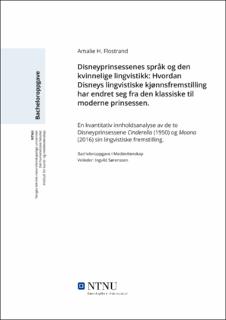Disneyprinsessenes språk og den kvinnelige lingvistikk: Hvordan Disneys lingvistiske kjønnsfremstilling har endret seg fra den klassiske til moderne prinsessen.
Bachelor thesis
Permanent lenke
https://hdl.handle.net/11250/2980211Utgivelsesdato
2020Metadata
Vis full innførselSamlinger
Sammendrag
Denne oppgaven undersøker hvordan det kvinnelige kjønn blir representert gjennom Disneyprinsesseneslingvistiske fremstilling, og hvordan denne fremstillingen har endret seg fra den klassiske prinsessen Cinderella (1950) til den moderne prinsessen Moana (2016). Ved å bruke Robin Lakoffs (1975) diagnostikk påkjønnsstereotypiske talekarakteristikker, vil oppgaven gjennomføre en kvantitativ innholdsanalyse av Cinderella og Moanas bruk av de kvinnelige talekarakteristikkene «tomme adjektiver», «hedges», «meningsløse kraftuttrykk» og «tag-spørsmål». Gjennom sammenligning av de to prinsessenes lingvistiske fremstilling er oppgavens mål å kunne identifisere en historisk utvikling av Disneys kjønnsfremstilling i perioden fra 1950 til 2016. This thesis explores how the female sex is represented through Disney princess's linguistic portrayal, and howthis representation has changed from the classic Princess Cinderella (1950) to the modern Princess Moana(2016). Using Robin Lakoff's (1975) diagnostics on sex stereotypical speech characteristics, this thesis willperform a quantitative content analysis of Cinderella and Moana’s use of the female speech characteristics"empty adjectives", "hedges", "meaningless particles" and "tag questions". By comparing the two DisneyPrincesses linguistic portrayal, this thesis aims to identify a historical evolution of Disney's gender representation in the periods from 1950 to 2016.
